
Concept explainers
(a)
Interpretation:
The polarity of the given molecule is to be determined.
Concept introduction:
The dipole moment of a molecule is a measure of the magnitude of its dipole. A dipole moment is a vector, which has both magnitude and direction. Bond polarity originates from bonds between atoms of different electronegativity. Symmetry of molecules also predicts the polarity of a molecule.
Answer to Problem 2.41P
The given molecule A is nonpolar.
Explanation of Solution
![]()
The given molecule is in trans form. The directions of the vectors of both the C-F bonds are equal but opposite to each other. Hence the dipole moments of both the C-F bonds get cancelled out with each other. Therefore, there is no net dipole moment.
Dipole moment on this molecule is symmetrically distributed; hence the given molecule A is nonpolar.
(b)
Interpretation:
The polarity of the given molecule is to be determined.
Concept introduction:
The dipole moment of a molecule is a measure of the magnitude of its dipole. A dipole moment is a vector, which has both magnitude and direction. Bond polarity originates from bonds between atoms of different electronegativity. Symmetry of molecules also predicts the polarity of a molecule.
Answer to Problem 2.41P
The given molecule B is polar.
Explanation of Solution

The given molecule is in cis form. The direction of vectors of both the C-F bonds is in the same direction, giving a net permanent dipole moment to the molecule.
Dipole moment on this molecule is not symmetrically distributed; hence the given molecule B is polar.
(c)
Interpretation:
The polarity of the given molecules is to be determined.
Concept introduction:
The dipole moment of a molecule is a measure of the magnitude of its dipole. A dipole moment is a vector, which has both magnitude and direction. Bond polarity originates from bonds between atoms of different electronegativity. Symmetry of molecules also predicts the polarity of a molecule.
Answer to Problem 2.41P
Molecule C is nonpolar.
Explanation of Solution
![]()
In this molecule, both the C-Cl bonds are opposite to each other, so the dipole moments are cancelled out with each other. Therefore, there is no net dipole moment in this molecule.
Dipole moment on this molecule is symmetrically distributed; hence the given molecule C is nonpolar.
(d)
Interpretation:
The polarity of the given molecules is to be determined.
Concept introduction:
The dipole moment of a molecule is a measure of the magnitude of its dipole. A dipole moment is a vector, which has both magnitude and direction. Bond polarity originates from bonds between atoms of different electronegativity. Symmetry of molecules also predicts the polarity of a.
Answer to Problem 2.41P
The given molecule D is polar.
Explanation of Solution
![]()
In this molecule, chlorine is more electronegative than the carbon atom; hence the direction of the vector of dipole moment is more towards C-Cl bond, giving a net dipole moment to the molecule.
Dipole moment on this molecule is not symmetrically distributed; hence the given molecule D is polar.
(e)
Interpretation:
The polarity of the given molecules is to be determined.
Concept introduction:
The dipole moment of a molecule is a measure of the magnitude of its dipole. A dipole moment is a vector, which has both magnitude and direction. Bond polarity originates from bonds between atoms of different electronegativity. Symmetry of molecules also predicts the polarity of a molecule.
Answer to Problem 2.41P
Molecule E is polar.
Explanation of Solution
![]()
In this molecule, Chlorine is more electronegative than bromine; hence the direction of the vector of dipole moment is more towards C-Cl bond, giving a net dipole moment to the molecule.
Dipole moment on this molecule is not symmetrically distributed; hence the given molecule E is polar.
(f)
Interpretation:
The polarity of the given molecules is to be determined.
Concept introduction:
The dipole moment of a molecule is a measure of the magnitude of its dipole. A dipole moment is a vector, which has both magnitude and direction. Bond polarity originates from bonds between atoms of different electronegativity. Symmetry of molecules also predicts the polarity of a molecule.
Answer to Problem 2.41P
Molecule F is nonpolar.
Explanation of Solution

In this molecule, there is no electronegative atom present since no charge separation is taking place. So there is no net dipole moment.
Dipole moment on this molecule is symmetrically distributed; hence the given molecule F is nonpolar.
(g)
Interpretation:
The polarity of the given molecules is to be determined.
Concept introduction:
The dipole moment of a molecule is a measure of the magnitude of its dipole. A dipole moment is a vector, which has both magnitude and direction. Bond polarity originates from bonds between atoms of different electronegativity. Symmetry of molecules also predicts the polarity of a molecule.
Answer to Problem 2.41P
Molecule G is polar.
Explanation of Solution
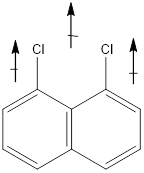
In this molecule, Chlorine is an electronegative atom, and both the C-Cl bonds are in the same direction. Therefore, the direction of the vector of dipole is moment is upward, giving a net dipole moment to the molecule.
Dipole moment on this molecule is not symmetrically distributed; hence the given molecule G is polar.
(h)
Interpretation:
The polarity of the given molecules is to be determined.
Concept introduction:
The dipole moment of a molecule is a measure of the magnitude of its dipole. A dipole moment is a vector, which has both magnitude and direction. Bond polarity originates from bonds between atoms of different electronegativity. Symmetry of molecules also predicts the polarity of a molecule.
Answer to Problem 2.41P
Molecule H is nonpolar.
Explanation of Solution
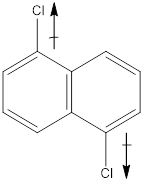
In the molecule, chlorine is an electronegative atom, and both the C-Cl bonds are in opposite direction. Therefore, the directions of the vectors of dipole moment of two C-Cl bonds get cancelled out with each other. Hence there is no net dipole moment.
Dipole moment on this molecule is symmetrically distributed; hence the given molecule H is nonpolar.
(i)
Interpretation:
The polarity of the given molecules is to be determined.
Concept introduction:
The dipole moment of a molecule is a measure of the magnitude of its dipole. A dipole moment is a vector, which has both magnitude and direction. Bond polarity originates from bonds between atoms of different electronegativity. Symmetry of molecules also predicts the polarity of a molecule.
Answer to Problem 2.41P
Molecule I is polar.
Explanation of Solution
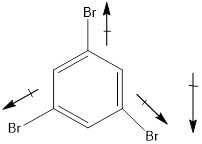
In this molecule, bromine is an electronegative atom, but one C-Br bond is in upward direction, and two C-Br bonds are in downward direction. Therefore, the net dipole moment acts in downward direction.
Dipole moment on this molecule is not symmetrically distributed; hence the given molecule I is polar.
(j)
Interpretation:
The polarity of the given molecules is to be determined.
Concept introduction:
The dipole moment of a molecule is a measure of the magnitude of its dipole. A dipole moment is a vector, which has both magnitude and direction. Bond polarity originates from bonds between atoms of different electronegativity. Symmetry of molecules also predicts the polarity of a molecule.
Answer to Problem 2.41P
Molecule J is polar.
Explanation of Solution
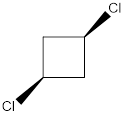
In this molecule, both the C-Cl bonds are present above the plane (that is wedge notation). Therefore, the directions of the vectors of dipole moment of both the C-Cl bonds are in the same direction, giving net dipole moment to the molecule.
Dipole moment on this molecule is not symmetrically distributed; hence the given molecule J is polar.
(k)
Interpretation:
The polarity of the given molecules is to be determined.
Concept introduction:
The dipole moment of a molecule is a measure of the magnitude of its dipole. A dipole moment is a vector, which has both magnitude and direction. Bond polarity originates from bonds between atoms of different electronegativity. Symmetry of molecules also predicts the polarity of a molecule.
Answer to Problem 2.41P
Molecule K is polar.
Explanation of Solution
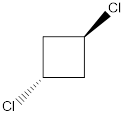
In this molecule, one C-Cl bond is present above the plane (that is, the wedge notation), and another C-Cl bond is present below the plane (that is, the dotted notation). Therefore, the directions of the vectors of dipole moment of both the C-Cl bonds are in opposite direction, which get cancelled out with each other, giving no net dipole moment to the molecule.
Dipole moment on this molecule is symmetrically distributed; hence the given molecule K is nonpolar.
(l)
Interpretation:
The polarity of the given molecules is to be determined.
Concept introduction:
The dipole moment of a molecule is a measure of the magnitude of its dipole. A dipole moment is a vector, which has both magnitude and direction. Bond polarity originates from bonds between atoms of different electronegativity. Symmetry of molecules also predicts the polarity of a molecule.
Answer to Problem 2.41P
Molecule L is polar.
Explanation of Solution

In this molecule, though both the C-Cl bonds are in opposite direction, both the chlorines are present on carbon
Dipole moment on this molecule is not symmetrically distributed; hence the given molecule L is polar.
(m)
Interpretation:
The polarity of the given molecules is to be determined.
Concept introduction:
The dipole moment of a molecule is a measure of the magnitude of its dipole. A dipole moment is a vector, which has both magnitude and direction. Bond polarity originates from bonds between atoms of different electronegativity. Symmetry of molecules also predicts the polarity of a molecule.
Answer to Problem 2.41P
Molecule M is nonpolar.
Explanation of Solution
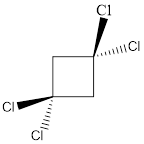
In this molecule, two C-Cl bonds are above the plane, and two C-Cl bonds are below the plane; hence the molecule has symmetry. The directions of the vectors of dipole moment of all the four C-Cl bonds are cancelled with each other, giving no net dipole moment to the molecule.
Dipole moment on this molecule is symmetrically distributed; hence the given molecule M is nonpolar.
(n)
Interpretation:
The polarity of the given molecules is to be determined.
Concept introduction:
The dipole moment of a molecule is a measure of the magnitude of its dipole. A dipole moment is a vector, which has both magnitude and direction. Bond polarity originates from bonds between atoms of different electronegativity. Symmetry of molecules also predicts the polarity of a molecule.
Answer to Problem 2.41P
Molecule N is polar.
Explanation of Solution
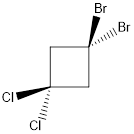
In this molecule, two C-Cl and two C-Br bonds are present. Since chlorine is more electronegative than bromine, the direction of the vector of dipole moment is towards C-Cl bonds. Therefore, there is a net dipole moment present in this molecule.
Dipole moment on this molecule is not symmetrically distributed; hence the given molecule N is polar.
Want to see more full solutions like this?
Chapter 2 Solutions
ORGANIC CHEMISTRY PRINCIPLES & MECHANISM
- An expression for the root mean square velocity, vrms, of a gas was derived. Using Maxwell’s velocity distribution, one can also calculate the mean velocity and the most probable velocity (mp) of a collection of molecules. The equations used for these two quantities are vmean=(8RT/πM)1/2 and vmp=(2RT/M)1/2 These values have a fixed relationship to each other.(a) Arrange these three quantities in order of increasing magnitude.(b) Show that the relative magnitudes are independent of the molar mass of the gas.(c) Use the smallest velocity as a reference for establishing the order of magnitude and determine the relationship between the larger and smaller values.arrow_forwardThe reaction of solid dimethylhydrazine, (CH3)2N2H2, and liquefied dinitrogen tetroxide, N2O4, has been investigated for use as rocket fuel. The reaction produces the gases carbon dioxide (CO2), nitrogen (N2), and water vapor (H2O), which are ejected in the exhaust gases. In a controlled experiment, solid dimethylhydrazine was reacted with excess dinitrogen tetroxide, and the gases were collected in a closed balloon until a pressure of 2.50 atm and a temperature of 400.0 K were reached.(a) What are the partial pressures of CO2, N2, and H2O?(b) When the CO2 is removed by chemical reaction, what are the partial pressures of the remaining gases?arrow_forwardOne liter of chlorine gas at 1 atm and 298 K reacts completely with 1.00 L of nitrogen gas and 2.00 L of oxygen gas at the same temperature and pressure. A single gaseous product is formed, which fills a 2.00 L flask at 1.00 atm and 298 K. Use this information to determine the following characteristics of the product:(a) its empirical formula;(b) its molecular formula;(c) the most favorable Lewis formula based on formal charge arguments (the central atom is N);(d) the shape of the molecule.arrow_forward
- How does the square root mean square velocity of gas molecules vary with temperature? Illustrate this relationship by plotting the square root mean square velocity of N2 molecules as a function of temperature from T=100 K to T=300 K.arrow_forwardDraw product B, indicating what type of reaction occurs. F3C CF3 NH2 Me O .N. + B OMearrow_forwardBenzimidazole E. State its formula. sState the differences in the formula with other benzimidazoles.arrow_forward
- Draw product A, indicating what type of reaction occurs. F3C CN CF3 K2CO3, DMSO, H₂O2 Aarrow_forward19) Which metal is most commonly used in galvanization to protect steel structures from oxidation? Lead a. b. Tin C. Nickel d. Zinc 20) The following molecule is an example of a: R₁ R2- -N-R3 a. Secondary amine b. Secondary amide c. Tertiary amine d. Tertiary amidearrow_forwardpls helparrow_forward
 Organic Chemistry: A Guided InquiryChemistryISBN:9780618974122Author:Andrei StraumanisPublisher:Cengage Learning
Organic Chemistry: A Guided InquiryChemistryISBN:9780618974122Author:Andrei StraumanisPublisher:Cengage Learning Chemistry: Matter and ChangeChemistryISBN:9780078746376Author:Dinah Zike, Laurel Dingrando, Nicholas Hainen, Cheryl WistromPublisher:Glencoe/McGraw-Hill School Pub Co
Chemistry: Matter and ChangeChemistryISBN:9780078746376Author:Dinah Zike, Laurel Dingrando, Nicholas Hainen, Cheryl WistromPublisher:Glencoe/McGraw-Hill School Pub Co Introductory Chemistry: An Active Learning Approa...ChemistryISBN:9781305079250Author:Mark S. Cracolice, Ed PetersPublisher:Cengage Learning
Introductory Chemistry: An Active Learning Approa...ChemistryISBN:9781305079250Author:Mark S. Cracolice, Ed PetersPublisher:Cengage Learning



